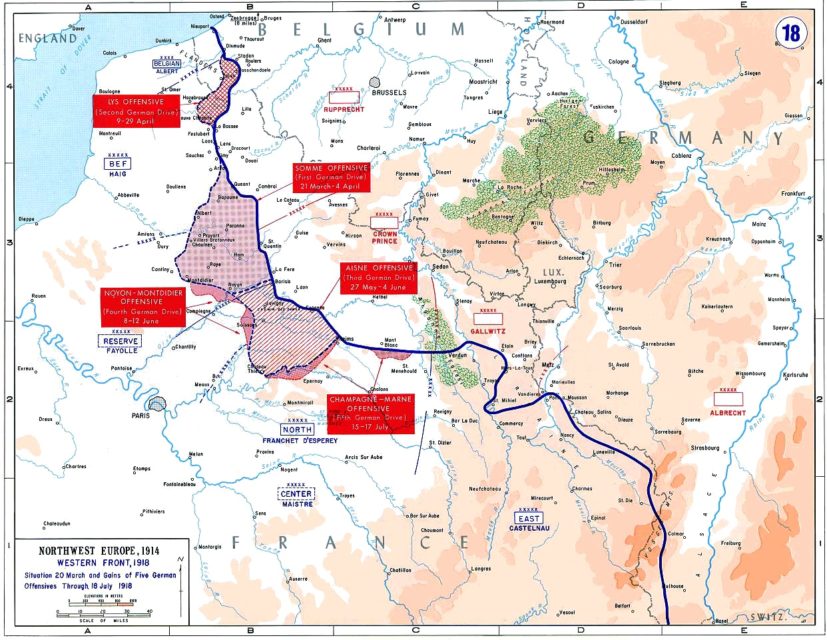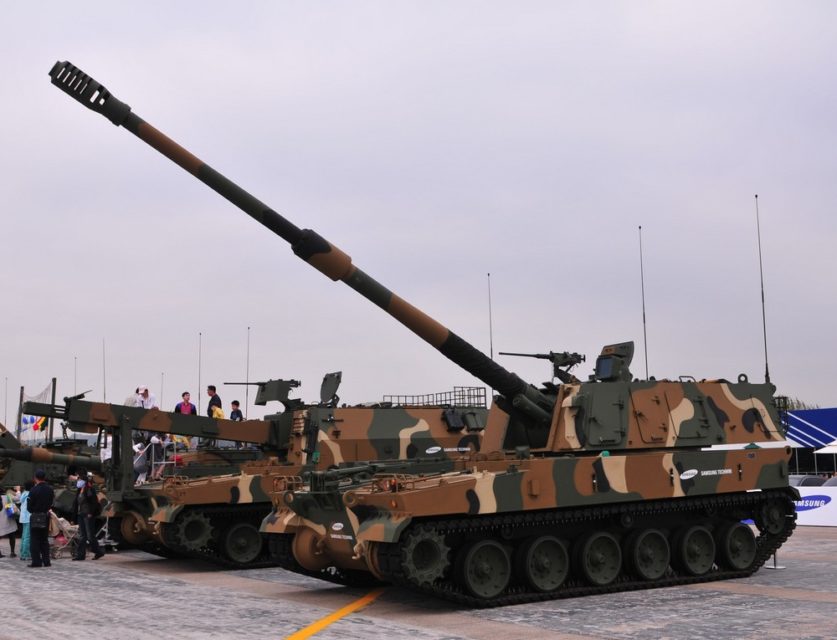The Great War
Published on 27 Mar 2018The German Operation Michael continues this week and after some uncertainty, the Germans put their eyes on Amiens. The city is a vital communications and transport hub for the Entente and so Ferdinand Foch decides to mount a defence in front of the city.
March 28, 2018
Backs To The Wall – All Eyes On Amiens I THE GREAT WAR Week 192
March 23, 2018
Kaiserschlacht – German Spring Offensive 1918 I THE GREAT WAR Week 191
The Great War
Published on 22 Mar 2018It was all or nothing for the German Army under General Erich Ludendorff now: They unleashed the biggest offensive of the entire war on the Western Front trying to split the British and French Armies, drive the British off the continent and capture Paris.
March 16, 2018
The Imperial German Army’s final throw of the dice – Operation Michael, March 1918
Victor Davis Hanson summarizes the Central Powers’ brief moment of strength early in 1918:
One hundred years ago this month, all hell broke loose in France. On March 21, 1918, the German army on the Western Front unleashed a series of massive attacks on the exhausted British and French armies.
German General Erich Ludendorff thought he could win World War I with one final blow. He planned to punch holes between the French and British armies. Then he would drive through their trenches to the English Channel, isolating and destroying the British army.
The Germans thought they had no choice but to gamble.
The British naval blockade of Germany after three years had reduced Germany to near famine. More than 200,000 American reinforcement troops were arriving each month in France. (Nearly 2 million would land altogether.) American farms and factories were sending over huge shipments of food and munitions to the Allies.
Yet for a brief moment, the war had suddenly swung in Germany’s favor by March 1918. The German army had just knocked Russia and its new Bolshevik government out of the war. The victory on the Eastern Front freed up nearly 1 million German and Austrian soldiers, who were transferred west.
Germany had refined new rolling artillery barrages. Its dreaded “Stormtroopers” had mastered dispersed advances. The result was a brief window of advantage before the American juggernaut changed the war’s arithmetic.
The Spring Offensive almost worked. Within days, the British army had suffered some 50,000 casualties. Altogether, about a half-million French, British and American troops were killed or wounded during the entire offensive.
But within a month, the Germans were sputtering. They could get neither supplies nor reinforcements to the English Channel. Germany had greedily left 1 million soldiers behind in the east to occupy and annex huge sections of conquered Eastern Europe and western Russia.
The British and French had learned new ways of strategic retreat. By summer of 2018, the Germans were exhausted. In August, the Allies began their own (even bigger) offensive and finally crushed the retreating Germans, ending the war in November 1918.
For more information on Operation Michael, sometimes known as “The Kaiser’s Battle”, here’s the Wikipedia entry.
March 13, 2018
German Tactics For 1918 Spring Offensive I THE GREAT WAR Special
The Great War
Published on 12 Mar 2018The German Spring Offensive in 1918, the so called Kaiserschlacht or Operation Michael, was the biggest German offensive of World War 1 and Quartermaster-general Erich Ludendorff prepared his troops for this battle by incorporating everything the German Army had learned in this war until now. Hutier Infiltration Tactics, Georg Bruchmüller’s artillery targeting and more lessons from the Eastern Front mean the Entente was facing a different army than before.
March 7, 2018
Tank Chats #23 Hornsby Tractor | The Tank Museum
The Tank Museum
Published on 15 Jul 2016In the 23rd Tank Chat, David Fletcher takes a look at the Hornsby Tractor. The Hornsby Tractor was the first tracked vehicle in service with the British Army. They were designed to tow artillery.
The Museum’s example is still running and is the oldest vehicle in the collection.
http://tankmuseum.org/museum-online/vehicles/object-e1958-15
March 6, 2018
Cannon loading in the eighteenth century
Lindybeige
Published on 24 Sep 2015In Fort Rinella. Kalkara, Malta, every day, they put on a show of loading and firing cannons, and members of the public are invited (for a fee) to fire them off.
The cannon shown are eighteenth century barrels mounted on more modern carriages. The uniforms worn by the crew do not match those worn by eighteenth century artillerymen, but these same men were just minutes before performing a Victorian infantry drill, and are still dressed for that.
The loading process shown here is not complete, because it lacks the vital stage of ramming in the ball and wadding. The carriages each have a stopper behind them, securely fixed down into the ground, so that they do not recoil backwards dangerously, and since no heavy ball is being fired, there is not nearly so much recoil as there would be in a battle.
See also: http://www.fortrinella.com
Lindybeige: a channel of archaeology, ancient and medieval warfare, rants, swing dance, travelogues, evolution, and whatever else occurs to me to make.
February 23, 2018
Artillery Combat in World War 1
Military History Visualized
Published on 6 Jun 2016This video will focus on how the use of Artillery changed throughout the war and cover some of the many major innovations. Artillery tactics changed to a large degree from 1914 to 1918, whereas in 1914 the use of artillery in tactics and techniques had still a strong resemblance to the Napoleonic era, in 1918 the foundations of a modern artillery is clearly recognizable. Although the basic principles of indirect fire, massed fire, counter-battery fire, calibration and meteorological corrections and combined arms were known, they were usually not applied on the field in 1914, yet in 1918 these principles were used consistently and to a large degree by all sides.
Script and further information: http://militaryhistoryvisualized.com/artillery-combat-in-the-first-world-war/
January 9, 2018
German Anti-Tank Units – Herman Göring – Caltrops I OUT OF THE TRENCHES
The Great War
Published on 8 Jan 2018Ask your questions here: http://outofthetrenches.thegreatwar.tv
December 3, 2017
Shell Recycling – WW1 Monuments in WW2 – Resistance Movements I OUT OF THE TRENCHES
The Great War
Published on 2 Dec 2017Chair of Wisdom Time!
July 8, 2017
Four Fun Facts about the Oerlikon 20mm Antiaircraft Cannon!
Published on 13 Apr 2017
The 20mm Oerlikon automatic cannon was a mainstay of United States naval air defense during World War 2, and today we will look at a few of the characteristics and questions that apply to this sort of automatic cannon but not to typical small arms. Like, for instance, how do you cock a gun that has a 400 pound recoil spring? Or, what happens if you fire a high explosive shell into your muzzle cover?
June 11, 2017
Creeping Barrage – Desert Tanks I OUT OF THE TRENCHES
Published on 10 Jun 2017
This week Indy discusses the invention of the Creeping Barrage and how tanks fared in the desert.
April 22, 2017
Flamethrower Units – Handling of Prisoners – Artillery Fuses I OUT OF THE TRENCHES
Published on 22 Apr 2017
In this week’s episode, Indy talks about flamethrower units, the handling of war prisoners and different types of artillery fuses.
April 18, 2017
Western Front Artillery At The Outbreak of World War 1 I THE GREAT WAR Special
Published on 17 Apr 2017
World War 1 was a war of artillery, 75% of casualties are attributed to artillery fire. And since the late 19th century the development of field canons, howitzers and mortars had made rapid progress. We are taking a look at the standard artillery pieces of the German, French and British Army at the outbreak of the war in this first part of a new series.
April 1, 2017
South Korean Thunder for Finland
Last month, Strategy Page reported on a recent deal for Finland to purchase a number of K-9 “Thunder” 155mm self-propelled guns from South Korea:
Finland has ordered 48 South Korean K-9 “Thunder” 155 mm self-propelled howitzers for about $3.3 million each. This price includes training, spare parts, maintenance and howitzer modernization to Finland standards (installation of Finnish made communication equipment and battle management system). The contract also includes an option for additional K-9s. Deliveries begin by the end of 2017 and all 48 vehicles should arrive to Finland till 2024. Nearby Estonia will now be able to get valuable advice from Finland to determine if Estonia should go forward with a similar purchase of twelve K-9s.
In 2016 the Finns began negotiating the K-9 purchase terms with South Korea because the Finns had determined that the K-9 was the least expensive option to obtain modern self-propelled howitzers that could be easily handled by the conscripts Finland still depends on for most of their military manpower. By the end of 2016 the Finns had confirmed this with field trials of the K-9 which as expected, performed better than competitors.
K-9 is a South Korean designed and manufactured self-propelled howitzer which was developed as a replacement for the K55 (license variant of M109). K-9 is a 48 ton self-propelled howitzer operated by a crew of five and using a NATO standard 155mm gun which can take out targets 40 kilometers away. Development of the K-9 began in 1989 and mass production began in 1999.
February 19, 2017
French Railway Guns – Physical Requirements For WW1 Pilots I OUT OF THE ETHER
Published on 18 Feb 2017
It’s time for another episode of Out Of The Ether – Indy reads the best and most insightful comments of recent weeks. This week we talk about French railway guns and the physical and mental requirements of World War 1 pilots.





